以前的文章看过缓冲区buffer了,libevent用bufferevent来负责管理缓冲区与buffer读写事件。
今天就带大家看下evbuffer.c,使用bufferevent处理事件的数据,是buffer和event的综合。在最后用一个稍微综合的例子看下使用bufferevent的整个流程。
首先依旧看下bufferevent的结构。结构很清晰。源码版本1.4.14。
1 struct bufferevent {
2 struct event_base *ev_base;
3
4 //读事件
5 struct event ev_read;
6 //写事件
7 struct event ev_write;
8 //读缓冲区,输入缓冲
9 struct evbuffer *input;
10 //写缓冲区,输出缓冲
11 struct evbuffer *output;
12
13 //读水位
14 struct event_watermark wm_read;
15 //写水位
16 struct event_watermark wm_write;
17
18 //发生读触发用户设置的回调
19 evbuffercb readcb;
20 //发生写触发用户设置的回调
21 evbuffercb writecb;
22 //发生错误触发用户设置的回调
23 everrorcb errorcb;
24 //当前设置的回调函数传递的参数,和上面3个回调配合使用
25 void *cbarg;
26
27 //设置读超时时间,默认为0
28 int timeout_read; /* in seconds */
29 //设置写超时时间,默认为0
30 int timeout_write; /* in seconds */
31
32 //当前事件是否可用
33 short enabled; /* events that are currently enabled */
34 };
35 //水位
36 struct event_watermark {
37 //低水位
38 size_t low;
39 //高水位
40 size_t high;
41 };
evbuffer中有2个缓冲区,一个是读缓冲区,一个写缓冲区。分别用来处理读写事件的数据。
evbuffer中有读水位和写水位,分别对应了读缓冲区和写缓冲区。
里面有个水位的概念。其实很好理解。水位有一个高水位,一个低水位。
如果水位达到高水位时,不能再往里面灌水了。如果水位达到低水位,不能再从中取水了。
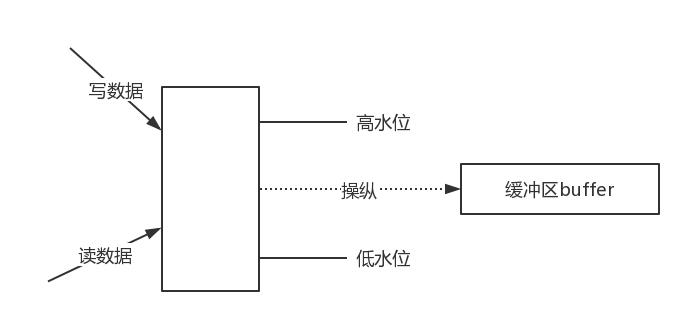
读操作发生时:如果高于高水位,那就不能再读入数据了,等待数据被读掉然后再开始读入数据。低水位只做判断。低水位不为0,如果缓冲区低于低水位,可以继续直接读数据到缓冲区。
写操作发生时:如果写缓冲区数据长度小于等于低水位,触发用户写事件,通知用户。写数据高水位没用。因为写数据是把缓冲区的数据读出写到对应的文件描述符中,所以水位肯定是下降的。
我的理解:水位控制了信息的颗粒度,多少数据触发次用户事件。数据缓冲区降低了频繁申请内存带来的开销。
接着我们来看evbuffer.c中最重要的几个函数
1.bufferevent_new
进行一些初始化。最重要的是指定了eventbuffer内部读写事件的回调,bufferevent_readcb与bufferevent_writecb。当前也可以通过后面的bufferevent_setcb实现。
1 struct bufferevent *
2 bufferevent_new(int fd, evbuffercb readcb, evbuffercb writecb,
3 everrorcb errorcb, void *cbarg)
4 {
5 struct bufferevent *bufev;
6
7 //申请内存空间并且初始化,使用calloc
8 if ((bufev = calloc(1, sizeof(struct bufferevent))) == NULL)
9 return (NULL);
10
11 if ((bufev->input = evbuffer_new()) == NULL) {
12 free(bufev);
13 return (NULL);
14 }
15
16 if ((bufev->output = evbuffer_new()) == NULL) {
17 evbuffer_free(bufev->input);
18 free(bufev);
19 return (NULL);
20 }
21 //读事件关联回调,传递参数
22 event_set(&bufev->ev_read, fd, EV_READ, bufferevent_readcb, bufev);
23
24 //写事件关联回调,传递参数
25 event_set(&bufev->ev_write, fd, EV_WRITE, bufferevent_writecb, bufev);
26
27 //设置bufferevent的读、写和出错事件回调,并且传递cbarg参数。
28 bufferevent_setcb(bufev, readcb, writecb, errorcb, cbarg);
29
30 /*
31 * Set to EV_WRITE so that using bufferevent_write is going to
32 * trigger a callback. Reading needs to be explicitly enabled
33 * because otherwise no data will be available.
34 */
35 //开启可写,否则无法执行写入回调
36 bufev->enabled = EV_WRITE;
37
38 return (bufev);
39 }
2.bufferevent_readcb
读事件,最先接触到数据,读出数据然后写入缓冲区
首先看下bufferevent_readcb的流程图
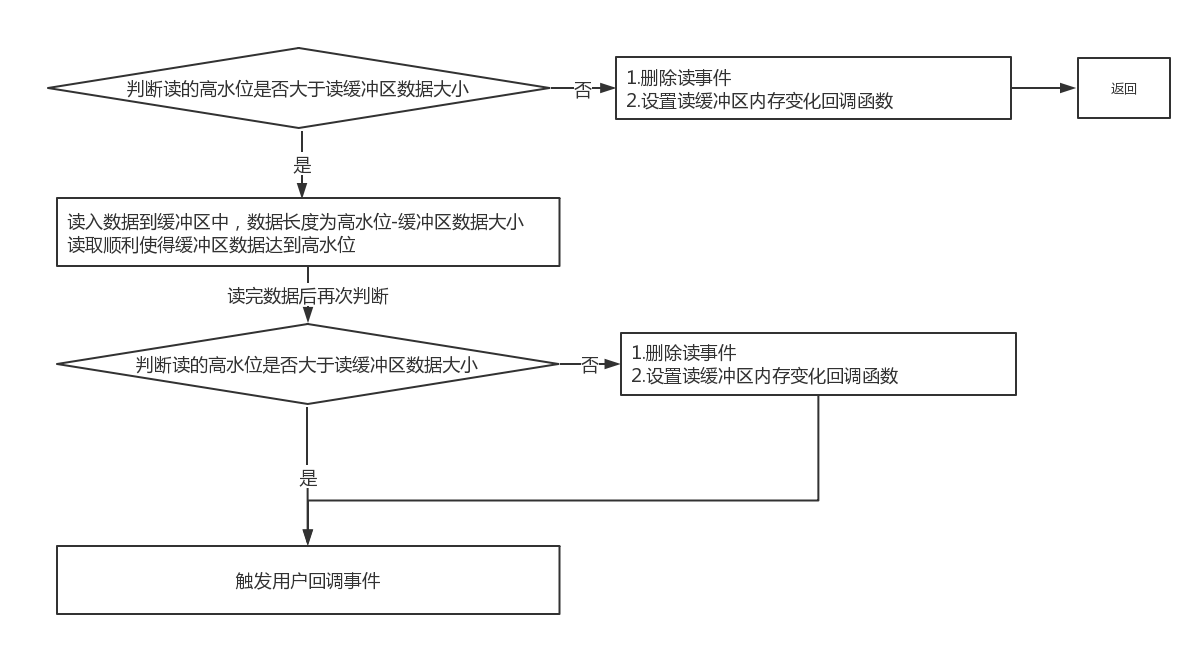
1 //读事件,最先接触到数据,读出数据然后写入缓冲区
2 static void
3 bufferevent_readcb(int fd, short event, void *arg)
4 {
5 struct bufferevent *bufev = arg;
6 int res = 0;
7 short what = EVBUFFER_READ;
8 size_t len;
9 int howmuch = -1;
10 //超时事件,报错
11 if (event == EV_TIMEOUT) {
12 what |= EVBUFFER_TIMEOUT;
13 goto error;
14 }
15
16 /*
17 * If we have a high watermark configured then we don't want to
18 * read more data than would make us reach the watermark.
19 */
20 //查看高水位,如果缓冲区数据已经高于高水位,不应该再写入。
21 if (bufev->wm_read.high != 0) {
22 howmuch = bufev->wm_read.high - EVBUFFER_LENGTH(bufev->input);
23 /* we might have lowered the watermark, stop reading */
24 if (howmuch <= 0) {
25 struct evbuffer *buf = bufev->input;
26 //达到高水位,删除读入事件,不再读入数据到缓冲区
27 event_del(&bufev->ev_read);
28 //设置bufev->input变化需要调用的回调函数和回调参数
29 evbuffer_setcb(buf,
30 bufferevent_read_pressure_cb, bufev);
31 return;
32 }
33 }
34 //没达到高水位,读取数据到input缓冲区中
35 res = evbuffer_read(bufev->input, fd, howmuch);
36 if (res == -1) {
37 //信号中断等一些原因,goto reschedule,可以继续。
38 if (errno == EAGAIN || errno == EINTR)
39 goto reschedule;
40 /* error case */
41 what |= EVBUFFER_ERROR;
42 } else if (res == 0) {
43 /* eof case */
44 what |= EVBUFFER_EOF;
45 }
46
47 if (res <= 0)
48 goto error;
49 //读事件加入事件队列
50 bufferevent_add(&bufev->ev_read, bufev->timeout_read);
51
52 /* See if this callbacks meets the water marks */
53 len = EVBUFFER_LENGTH(bufev->input);
54 if (bufev->wm_read.low != 0 && len < bufev->wm_read.low)
55 return;
56 //如果高水位不为0,并且缓冲区数据长度已经不小于高水位了,触发事件。
57 if (bufev->wm_read.high != 0 && len >= bufev->wm_read.high) {
58 //缓冲区数据已经不小于高水位,不能再进数据了,删除读缓冲区的读外部数据事件
59 struct evbuffer *buf = bufev->input;
60 event_del(&bufev->ev_read);
61
62 /* Now schedule a callback for us when the buffer changes */
63 //缓冲区大小发生变化,触发回调
64 //设置回调函数和回调参数
65 evbuffer_setcb(buf, bufferevent_read_pressure_cb, bufev);
66 }
67
68 /* Invoke the user callback - must always be called last */
69 //触发用户回调事件
70 if (bufev->readcb != NULL)
71 (*bufev->readcb)(bufev, bufev->cbarg);
72 return;
73
74 reschedule:
75 //读事件加入事件队列,继续进行读取
76 bufferevent_add(&bufev->ev_read, bufev->timeout_read);
77 return;
78
79 error:
80 (*bufev->errorcb)(bufev, what, bufev->cbarg);
81 }
3.bufferevent_writecb
写事件
1 static void
2 bufferevent_writecb(int fd, short event, void *arg)
3 {
4 //事件缓冲区管理
5 struct bufferevent *bufev = arg;
6 int res = 0;
7 short what = EVBUFFER_WRITE;
8
9 //超时事件,报错
10 if (event == EV_TIMEOUT) {
11 what |= EVBUFFER_TIMEOUT;
12 goto error;
13 }
14
15 if (EVBUFFER_LENGTH(bufev->output)) {
16 //将缓冲区数据读出,写入到fd文件描述符对应的文件中
17 res = evbuffer_write(bufev->output, fd);
18 if (res == -1) {
19 #ifndef WIN32
20 /*todo. evbuffer uses WriteFile when WIN32 is set. WIN32 system calls do not
21 *set errno. thus this error checking is not portable*/
22 if (errno == EAGAIN ||
23 errno == EINTR ||
24 errno == EINPROGRESS)
25 goto reschedule;
26 /* error case */
27 what |= EVBUFFER_ERROR;
28
29 #else
30 goto reschedule;
31 #endif
32
33 } else if (res == 0) {
34 /* eof case */
35 what |= EVBUFFER_EOF;
36 }
37 if (res <= 0)
38 goto error;
39 }
40 //缓冲区不为0,写事件加入执行队列
41 if (EVBUFFER_LENGTH(bufev->output) != 0)
42 bufferevent_add(&bufev->ev_write, bufev->timeout_write);
43
44 /*
45 * Invoke the user callback if our buffer is drained or below the
46 * low watermark.
47 */
48 //缓冲区数据长度低于低水位,用户写事件触发。
49 if (bufev->writecb != NULL &&
50 EVBUFFER_LENGTH(bufev->output) <= bufev->wm_write.low)
51 (*bufev->writecb)(bufev, bufev->cbarg);
52 return;
53
54 reschedule:
55 if (EVBUFFER_LENGTH(bufev->output) != 0)
56 bufferevent_add(&bufev->ev_write, bufev->timeout_write);
57 return;
58
59 error:
60 (*bufev->errorcb)(bufev, what, bufev->cbarg);
61 }
示例
下面看一个改造过的服务器和客户端的例子。(当前你可以直接使用test中的regress.c例子,我这边因为libevent本来就是用来解决网络问题的,所以自己就用了这个例子)
server.c
我的编译命令:gcc -g -Wall -I/usr/local/include -o server server.c -L/usr/local/lib -levent
服务端监听所有socket。端口5555。这里我们为了演示:evbuffer读缓冲区对应水位设置为高水位10,低水位0。
1 /*
2 * libevent echo server example using buffered events.
3 */
4
5 #include <sys/types.h>
6 #include <sys/socket.h>
7 #include <netinet/in.h>
8 #include <arpa/inet.h>
9
10 /* Required by event.h. */
11 #include <sys/time.h>
12
13 #include <stdlib.h>
14 #include <stdio.h>
15 #include <string.h>
16 #include <fcntl.h>
17 #include <unistd.h>
18 #include <errno.h>
19 #include <err.h>
20
21 /* Libevent. */
22 #include <event.h>
23
24 /* Port to listen on. */
25 #define SERVER_PORT 5555
26
27 /**
28 * A struct for client specific data, also includes pointer to create
29 * a list of clients.
30 */
31 struct client {
32 /* The clients socket. */
33 int fd;
34
35 /* The bufferedevent for this client. */
36 struct bufferevent *buf_ev;
37 };
38
39 /**
40 * Set a socket to non-blocking mode.
41 */
42 //用于设置非阻塞
43 int
44 setnonblock(int fd)
45 {
46 int flags;
47
48 flags = fcntl(fd, F_GETFL);
49 if (flags < 0)
50 return flags;
51 flags |= O_NONBLOCK;
52 if (fcntl(fd, F_SETFL, flags) < 0)
53 return -1;
54
55 return 0;
56 }
57
58 /**
59 * Called by libevent when there is data to read.
60 */
61 void
62 buffered_on_read(struct bufferevent *bev, void *arg)
63 {
64 /* Write back the read buffer. It is important to note that
65 * bufferevent_write_buffer will drain the incoming data so it
66 * is effectively gone after we call it. */
67 char msg[4096];
68
69 size_t len = bufferevent_read(bev, msg, sizeof(msg));
70
71 msg[len] = '\0';
72 printf("recv the client msg: %s\n", msg);
73
74 char reply_msg[4096] = "I have recvieced the msg: ";
75 strcat(reply_msg + strlen(reply_msg), msg);
76 bufferevent_write(bev, reply_msg, strlen(reply_msg));
77
78 }
79
80 /**
81 * Called by libevent when the write buffer reaches 0. We only
82 * provide this because libevent expects it, but we don't use it.
83 */
84 //当写缓冲区达到低水位时触发调用,我们这边不用
85 void
86 buffered_on_write(struct bufferevent *bev, void *arg)
87 {
88
89 }
90
91 /**
92 * Called by libevent when there is an error on the underlying socket
93 * descriptor.
94 */
95 void
96 buffered_on_error(struct bufferevent *bev, short what, void *arg)
97 {
98 struct client *client = (struct client *)arg;
99
100 if (what & EVBUFFER_EOF) {
101 /* Client disconnected, remove the read event and the
102 * free the client structure. */
103 printf("Client disconnected.\n");
104 }
105 else {
106 warn("Client socket error, disconnecting.\n");
107 }
108 bufferevent_free(client->buf_ev);
109 close(client->fd);
110 free(client);
111 }
112
113 /**
114 * This function will be called by libevent when there is a connection
115 * ready to be accepted.
116 */
117 void
118 on_accept(int fd, short ev, void *arg)
119 {
120 int client_fd;
121 struct sockaddr_in client_addr;
122 socklen_t client_len = sizeof(client_addr);
123 struct client *client;
124
125 client_fd = accept(fd, (struct sockaddr *)&client_addr, &client_len);
126 if (client_fd < 0) {
127 warn("accept failed");
128 return;
129 }
130
131 /* Set the client socket to non-blocking mode. */
132 if (setnonblock(client_fd) < 0)
133 warn("failed to set client socket non-blocking");
134
135 /* We've accepted a new client, create a client object. */
136 client = calloc(1, sizeof(*client));
137 if (client == NULL)
138 err(1, "malloc failed");
139 client->fd = client_fd;
140
141 /* Create the buffered event.
142 *
143 * The first argument is the file descriptor that will trigger
144 * the events, in this case the clients socket.
145 *
146 * The second argument is the callback that will be called
147 * when data has been read from the socket and is available to
148 * the application.
149 *
150 * The third argument is a callback to a function that will be
151 * called when the write buffer has reached a low watermark.
152 * That usually means that when the write buffer is 0 length,
153 * this callback will be called. It must be defined, but you
154 * don't actually have to do anything in this callback.
155 *
156 * The fourth argument is a callback that will be called when
157 * there is a socket error. This is where you will detect
158 * that the client disconnected or other socket errors.
159 *
160 * The fifth and final argument is to store an argument in
161 * that will be passed to the callbacks. We store the client
162 * object here.
163 */
164 client->buf_ev = bufferevent_new(client_fd, buffered_on_read,
165 buffered_on_write, buffered_on_error, client);
166 client->buf_ev->wm_read.high = 10;
167 client->buf_ev->wm_read.low = 0;
168 /* We have to enable it before our callbacks will be
169 * called. */
170 bufferevent_enable(client->buf_ev, EV_READ);
171
172 printf("Accepted connection from %s\n",
173 inet_ntoa(client_addr.sin_addr));
174 }
175
176 int
177 main(int argc, char **argv)
178 {
179 int listen_fd;
180 struct sockaddr_in listen_addr;
181 struct event ev_accept;
182 int reuseaddr_on;
183
184 /* Initialize libevent. */
185 event_init();
186
187 /* Create our listening socket. */
188 listen_fd = socket(AF_INET, SOCK_STREAM, 0);
189 if (listen_fd < 0)
190 err(1, "listen failed");
191 memset(&listen_addr, 0, sizeof(listen_addr));
192 listen_addr.sin_family = AF_INET;
193 listen_addr.sin_addr.s_addr = INADDR_ANY;
194 listen_addr.sin_port = htons(SERVER_PORT);
195 if (bind(listen_fd, (struct sockaddr *)&listen_addr,
196 sizeof(listen_addr)) < 0)
197 err(1, "bind failed");
198 if (listen(listen_fd, 5) < 0)
199 err(1, "listen failed");
200 reuseaddr_on = 1;
201 setsockopt(listen_fd, SOL_SOCKET, SO_REUSEADDR, &reuseaddr_on,
202 sizeof(reuseaddr_on));
203
204 /* Set the socket to non-blocking, this is essential in event
205 * based programming with libevent. */
206 if (setnonblock(listen_fd) < 0)
207 err(1, "failed to set server socket to non-blocking");
208
209 /* We now have a listening socket, we create a read event to
210 * be notified when a client connects. */
211 event_set(&ev_accept, listen_fd, EV_READ | EV_PERSIST, on_accept, NULL);
212 event_add(&ev_accept, NULL);
213
214 /* Start the event loop. */
215 event_dispatch();
216
217 return 0;
218 }
client.c
读键盘输入,发送到服务端,服务端再返回,客户端回显。
gcc -g -Wall -I/usr/local/include -o client client.c -L/usr/local/lib -levent
1 #include<sys/types.h>
2 #include<sys/socket.h>
3 #include<netinet/in.h>
4 #include<arpa/inet.h>
5 #include<errno.h>
6 #include<unistd.h>
7
8 #include <stdlib.h>
9 #include <stdio.h>
10 #include <string.h>
11 #include <fcntl.h>
12 #include <err.h>
13
14 #include<event.h>
15
16 #define SERVER_PORT 5555
17
18
19 //服务端信息
20 struct server {
21 /* The server socket. */
22 int fd;
23
24 /* The bufferedevent for this server. */
25 struct bufferevent *buf_ev;
26 };
27
28 //全局server数据
29 struct server *serv;
30
31 //设置文件状态标记
32 int setnonblock(int fd)
33 {
34 int flags;
35 flags = fcntl(fd, F_GETFL);
36 if (flags < 0)
37 return flags;
38 flags |= O_NONBLOCK;
39 if (fcntl(fd, F_SETFL, flags) < 0)
40 return -1;
41 return 0;
42 }
43
44 //键盘事件
45 void cmd_msg_cb(int fd, short events, void* arg)
46 {
47 printf("cmd_msg_cb\n");
48 char msg[1024];
49
50 int ret = read(fd, msg, sizeof(msg));
51 if (ret < 0)
52 {
53 perror("read fail ");
54 exit(1);
55 }
56 struct bufferevent* bev = (struct bufferevent*)arg;
57 //把终端的消息发送给服务器端
58 bufferevent_write(bev, msg, ret);
59 }
60
61 //读服务端发来的数据
62 void read_msg_cb(struct bufferevent* bev, void* arg)
63 {
64 printf("read_msg_cb\n");
65 char msg[1024];
66
67 size_t len = bufferevent_read(bev, msg, sizeof(msg));
68 msg[len] = '\0';
69 printf("recv %s from server", msg);
70 }
71
72 //连接断开或者出错回调
73 void event_error(struct bufferevent *bev, short event, void *arg)
74 {
75 printf("event_error\n");
76 if (event & EVBUFFER_EOF)
77 printf("connection closed\n");
78 else if (event & EVBUFFER_ERROR)
79 printf("some other error\n");
80 struct event *ev = (struct event*)arg;
81 //因为socket已经没有,所以这个event也没有存在的必要了
82 free(ev);
83 //当发生错误退出事件循环
84 event_loopexit(0);
85 bufferevent_free(bev);
86 }
87
88 //连接到server
89 typedef struct sockaddr SA;
90 int tcp_connect_server(const char* server_ip, int port)
91 {
92 int sockfd, status, save_errno;
93 struct sockaddr_in server_addr;
94
95 memset(&server_addr, 0, sizeof(server_addr));
96
97 server_addr.sin_family = AF_INET;
98 server_addr.sin_port = htons(port);
99 status = inet_aton(server_ip, &server_addr.sin_addr);
100
101 if (status == 0) //the server_ip is not valid value
102 {
103 errno = EINVAL;
104 return -1;
105 }
106
107 sockfd = socket(AF_INET, SOCK_STREAM, 0);
108 if (sockfd == -1)
109 return sockfd;
110 status = connect(sockfd, (SA*)&server_addr, sizeof(server_addr));
111
112 if (status == -1)
113 {
114 save_errno = errno;
115 close(sockfd);
116 errno = save_errno; //the close may be error
117 return -1;
118 }
119
120 setnonblock(sockfd);
121
122 return sockfd;
123 }
124
125
126 int main(int argc, char** argv)
127 {
128
129 event_init();
130 //测试用直接连接本地server
131 int sockfd = tcp_connect_server("127.0.0.1", SERVER_PORT);
132 if (sockfd == -1)
133 {
134 perror("tcp_connect error ");
135 return -1;
136 }
137
138 printf("connect to server successful\n");
139 serv = calloc(1, sizeof(*serv));
140 if (serv == NULL)
141 err(1, "malloc failed");
142 serv->fd = sockfd;
143 serv->buf_ev = bufferevent_new(sockfd, read_msg_cb,
144 NULL, NULL, (void *)serv);
145
146 //监听终端输入事件
147 struct event *ev_cmd = calloc(1,sizeof(*ev_cmd));
148 event_set(ev_cmd, STDIN_FILENO,
149 EV_READ | EV_PERSIST, cmd_msg_cb,
150 (void*)serv->buf_ev);
151 event_add(ev_cmd, NULL);
152 //设置下read和发生错误的回调函数。(当socket关闭时会用到回调参数,删除键盘事件)
153 bufferevent_setcb(serv->buf_ev, read_msg_cb, NULL, event_error, (void*)ev_cmd);
154 bufferevent_enable(serv->buf_ev, EV_READ| EV_PERSIST);
155 event_dispatch();
156 printf("finished \n");
157 return 0;
158 }
过程
1.运行 ./server
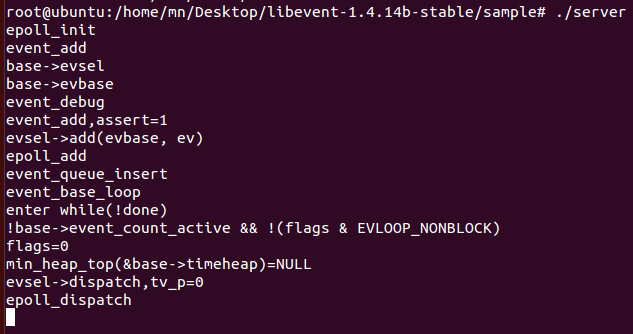
2.运行./client
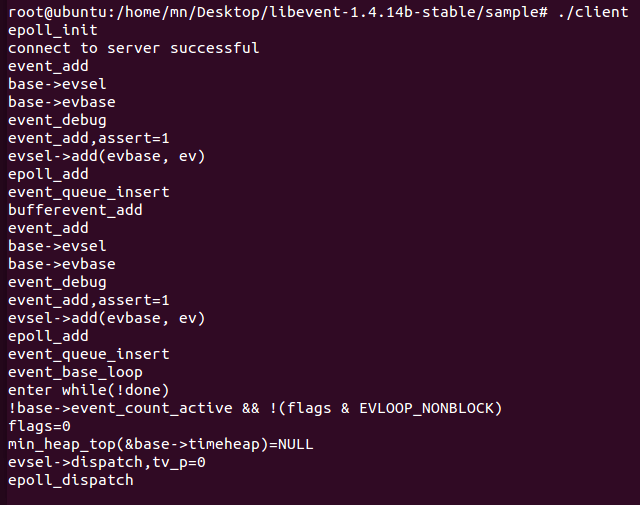
3.服务端显示连接成功
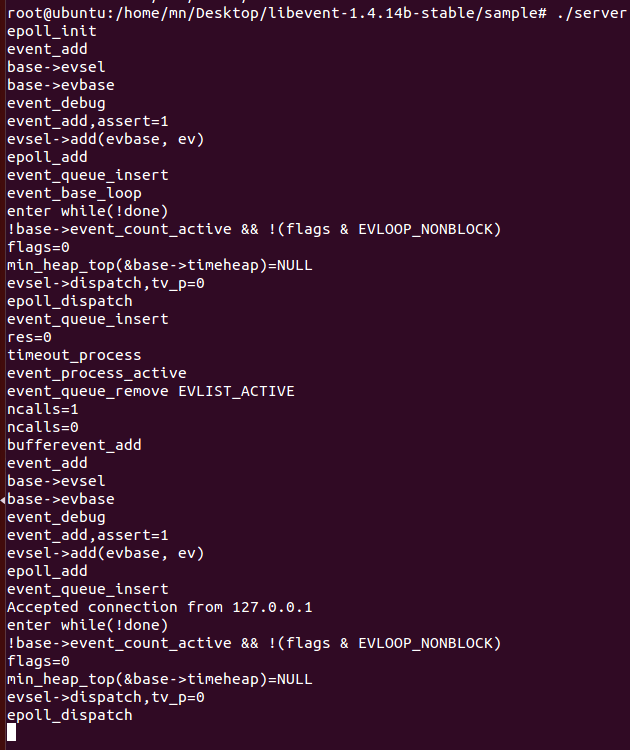
4.键入abcdefghijklmn回车
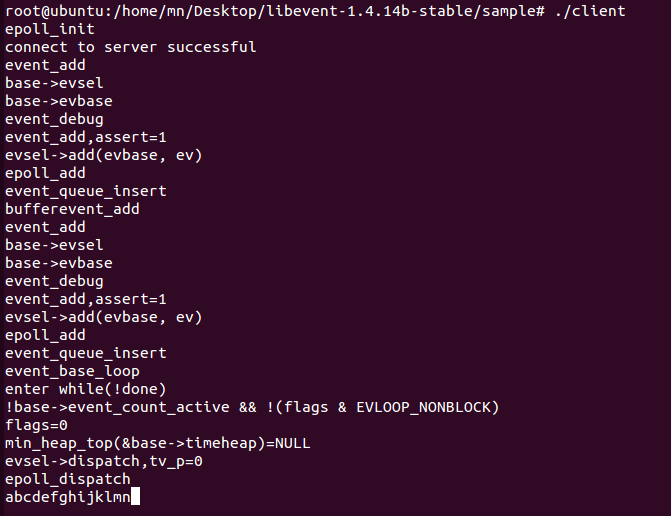
5.服务器接收到数据
由于读缓冲区高水位为10,低水位为0。所以接到abcdefghij后出发用户事件读掉缓冲区数据,然后再读klmn回车。多空一行是键盘输入的回车也读到了。
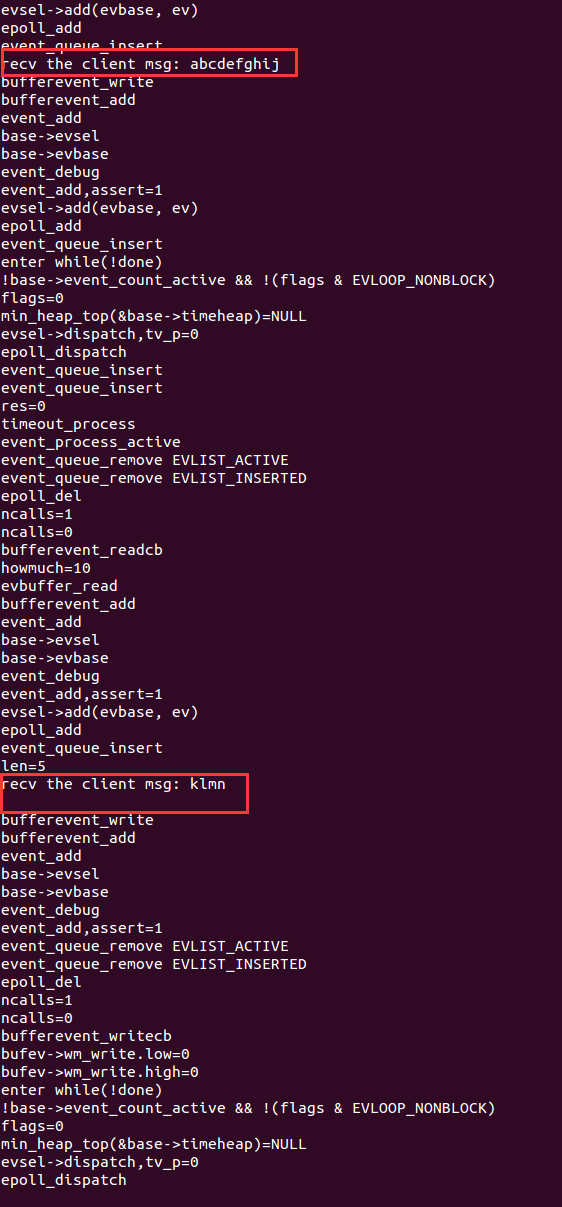
6.客户端回显
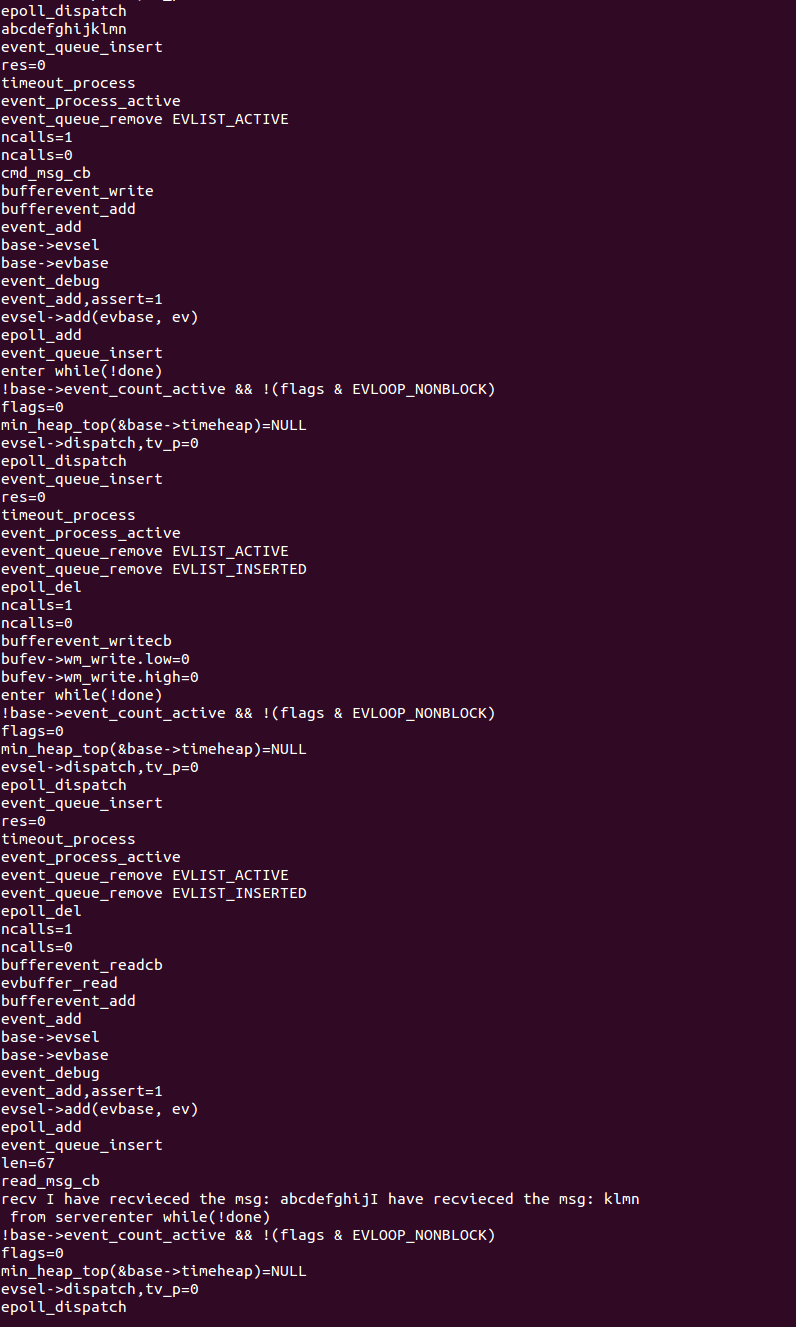
7.在服务端终端中按下ctrl+c
8.客户端如下
测试了client.c中加入的event_error。event_error执行退出事件循环。

来源:https://www.cnblogs.com/nengm1988/p/8203784.html